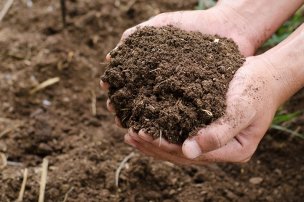
What’s the Dirt on Fertilizer?
So, you’re curious about the benefits of fertilizer? First, let’s talk about what it is and why it’s used.
Fertilizer is typically applied to soils and/or plant tissues (i.e., leaves) to add more nutrients that are essential in the growth process. It includes many components that are necessary to promoting plant growth and proper blooming.
Some nutrients come from the air and water, like carbon, hydrogen, and oxygen. There are also two categories of nutrients that are incorporated into fertilizers, called macronutrients and micronutrients.
The macronutrients are mostly used by plants and include nitrogen, phosphorus, potassium, calcium, magnesium, and sulfur. Of the macronutrients, there are the big three: nitrogen, phosphorus, and potassium, commonly referred to as NPK. The percentages used are often listed on fertilizer packaging with amounts separated by dashes (X-X-X). For example, NutriRoot has 2% nitrogen, 2% phosphorus, and 3% potassium, so it’s listed as 2-2-3. NPK are very useful nutrients that, when in different combinations, can affect plant growth depending on a plant’s needs. The formulations of nutrients can come in different quantities, so it’s important to know what is best for your garden.
Micronutrients are used only in small portions and include boron, chlorine, copper, iron, manganese, zinc, and molybdenum.
Why NPK is important
Nitrogen is a major component of proteins, chlorophyll, hormones, vitamins, and enzymes, and is essential for plant life. It helps with stem and leaf growth. When there is too much nitrogen, it can result in decaying or flowering prevention, and can cause yellowing of the leaves and stunted growth. Using more nitrogen in a formulation is helpful to increase overall plant growth and greening.
Phosphorus is required for photosynthesis, protein formation, flowering, and other aspects of growth and metabolism. When there is a deficiency of phosphorus, you can end up with purple leaves that slow down growth, lower quality flower production, and cause early flower loss.
Potassium is necessary in the growing process, too. It’s essential for sugar, starch, and carbohydrate creation, protein synthesis, and plant cell division. Potassium helps control water absorption/loss and improves plant durability, cold hardiness, and flower color. When there is too little potassium, leaves can curl or appear burnt. There also can be yellowing of leaves in between the leaf veins and purple spots on leaf undersides. Applying a formulation with more potassium and less nitrogen is recommended during warmer summer conditions when plants need to conserve their resources. Increase the amount of phosphorus and potassium when plants need to focus on growing more roots or producing more fruit.
Fertilizer can help plants thrive in many ways, such as:
- Synthesizing and producing chlorophyll
- Controlling water content
- Cell growth and division
- Respiration
- Nitrogen metabolism
- Flowering
- Pollen germination
- Seed development
- Water balance
- Protein synthesis
- Nitrogen fixation
- Iron absorption
- Producing stronger, tougher cell walls for more heat and drought tolerance
Using the proper fertilizer can help produce the health and longevity of plant life and reduce problems in the future. If you’re unsure where to start, try NutriRoot® 2-2-3 Liquid Soil Applied Fertilizer, designed to stimulate root growth and reduce water stress in trees, shrubs, and lawns. It also helps root development, water stress management, and nutritional deficiencies. ARBORChar® All Purpose Grow 5-6-4 is a fertilizer and biochar blend that not only offers your plants a balance of nutrients, but also helps build better soils.


Sorry, the comment form is closed at this time.